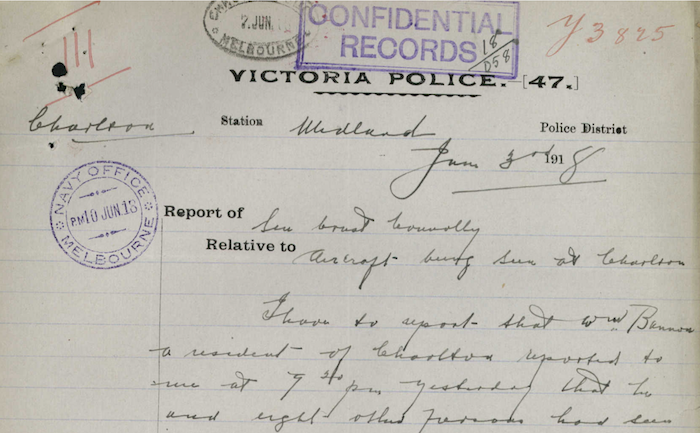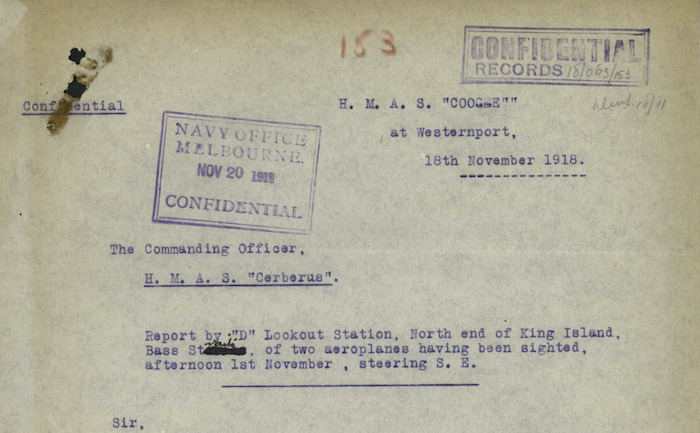
NAA: MP1049/1, 1918/066, page 836 is a report by Senior Constable P. J. Connolly regarding 'an aeroplane flying in a Westerly direction' seen at 9pm the previous evening at Charlton, in the Mallee region of Victoria, by William Bannon and no less than 'eight other farmers', who all saw the machine together:
One bright white light could be seen, and the [?] buzzing sound heard.
One of the witnesses, a returned soldier named Kenyon, claims 'that he 'is well used to aircraft, & in his opinion it was about twenty
There's a later, more detailed report at NAA: MP1049/1, 1918/066, page 835, made by somebody who went out to interview witnesses, unsigned but probably by somebody from military intelligence, given the cover letter by Major Hogan (at NAA: MP1049/1, 1918/066, page 834). The number of witnesses has now grown to 'about ten', perhaps due to the inclusion of Kenyon's wife. In additon, on the same night another group of 'about half a dozen people' saw something very similar out near Wooronook, which is about 16km west of Charlton; but at 10pm rather than 9pm (but then 'country people are not as a rule accurate about detail'!) There were also some reports of 'the engines of an aeroplane' heard at Charlton on Monday and Wednesday nights [3 and 5 June 1918] but the writer does not place much weight on them. The original group of witnesses, though, 'were speaking truthfully as far as their knowledge went, and I could see no reason to doubt their statements improbable as it seemed that an aeroplane would be in the locality'.
There are also more details on what was seen (incidentally, matching a report in the Age, clipped at NAA: MP1049/1, 1918/066, page 838):
[Kenyon] says the pilot appeared to be having some trouble with his engine for at times the noise would cease and then start again, the machine also appeared to rise and fall considerably. After a time the engine recovered and flew straight off in a westerly direction. When it had got a long way off a light flare appeared from it and it disappeared in the distance going west over Wooronook or Mt. Jaffert [handwritten annotation: Jeffcott].
The investigator doesn't point out that Sirius was setting in the west just at the time the farmers claimined to have seen an aeroplane with a light in that same direction, but does go on to say that:
Further west than Wooronook is a large lake called Boolook about 10 miles long which I understand would be a safe and sheltered landing for a plan [sic] fitted with floats.
Further west still I believe there is a large community of Germans with a German school.
If this story is correct it may connect with the reports of aeroplanes at Nyang.
It's surprising to see anyone at this late date still talking about the original Nyang incident, more than two months ago now and long since debunked. For that matter I would also have said it's surprising to see any aeroplane investigations still being carried out, except the Navy is still doing it too. Probably it was the large number of witnesses which attracted official interest in this case -- after all, that's why I cite it in my article (that and the fact they were farmers).
I also cite NAA: MP1049/1, 1918/066, page 895, which is a copy of a report by T. W. C. Deeby of Healesville police. It's not actually about aeroplanes at all; rather it concerns a 'complaint' about 'signal lights' seen at 9.30pm pm on 2 June 1918 by solicitor Reginald Kelly and his family (including a returned soldier):
The signals being in the form of a dot dash, Code and laster [sic] until about 10 p.m. Mr. Kelly states that the lights appeared to be showing from a spot on the Railway Station side of the school Hill to a spot somewhere near a place called 'Gowrie' to the S.W. of Healesville.
Ominously, Deeby notes that these lights have been reported to him before and 'the strange thing about it is that the lights are always shown when a big move is being made by the opposing armies in France'. Just why a German spy would be signalling in the Healesville hills when an offensive is launched on the Western Front is not entirely clear! Nor for that matter is why I've cited this source as 'T W C Deeby [Deeley?]' when the typescript is perfectly clear that it's the former, so that's another mystery I will never know the solution to.
![]() This work is licensed under a Creative Commons Attribution-NonCommercial-NoDerivatives 4.0 International License.
Permissions beyond the scope of this license may be available at http://airminded.org/copyright/.
This work is licensed under a Creative Commons Attribution-NonCommercial-NoDerivatives 4.0 International License.
Permissions beyond the scope of this license may be available at http://airminded.org/copyright/.




